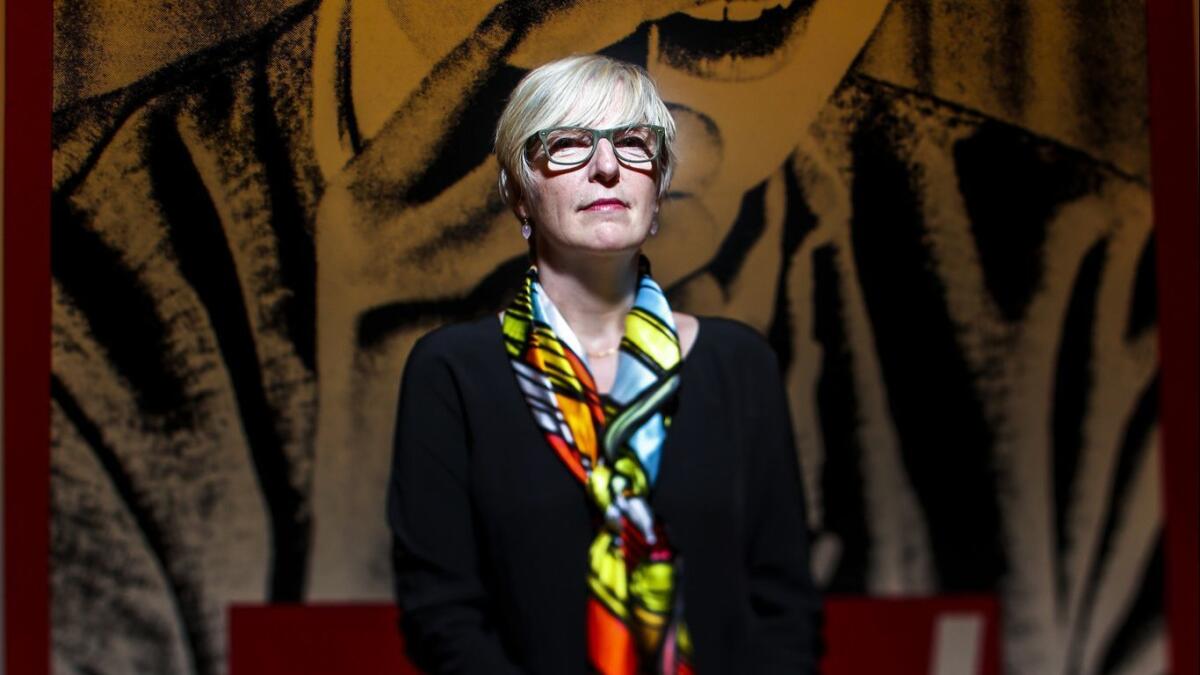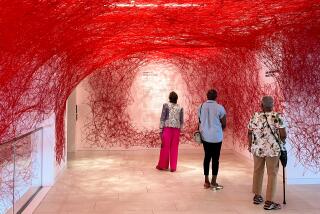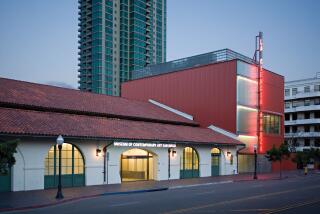Firing of MOCA’s chief curator triggers worry over the future of an artist-centric museum

- Share via
The unexpected firing of Helen Molesworth, the Museum of Contemporary Art’s highly respected chief curator, didn’t just shock the art world. It raised the question of a full-blown institutional identity crisis.
For almost 40 years, a MOCA point of pride has been that it was founded by artists.
But now many wonder if MOCA can continue to champion itself as an “artists’ museum.”
“I’m not sure how MOCA will recover from this,” said artist Analia Saban, whose work is represented in MOCA’s permanent collection. She believes it is an artists’ museum, “but there’s a recent history over the last six or seven years of artists saying they don’t feel heard.”
Artist Lari Pittman, who said the museum was losing “one of America’s gifted young curators,” resigned from the MOCA board earlier this year, noting an irreconcilable divide between Molesworth and MOCA Director Philippe Vergne.
“Artists never stand by directors, they stand by curators,” Pittman said. “I’m an artist and I stand by Helen.”
When asked if the museum’s board of trustees stands by Vergne’s decision, MOCA did not respond Wednesday.
The firing, first reported by The Times on Tuesday, prompted a statement from MOCA that said Vergne and Molesworth were parting ways because of “creative differences.” But artist board member Catherine Opie told The Times that Vergne said he had terminated Molesworth on Monday for “undermining the museum.”
When asked if the museum’s board of trustees stands by Vergne’s decision, MOCA did not respond Wednesday. Molesworth also did not reply to requests for comment.
Pittman pointed out that it’s extremely rare for a museum director to fire a chief curator, but MOCA has done it before. In 2012, then-Director Jeffrey Deitch forced out the highly respected Paul Schimmel.
“It doesn’t bode well for the institution,” Pittman said.
Molesworth’s departure comes at a weighty time for museums, which are increasingly scrutinized for democratic representation of artists, particularly women and people of color, said Nizan Shaked, a professor of contemporary art history, museum and curatorial studies at Cal State Long Beach. She cited two recent Molesworth-curated exhibitions, both popular and critically acclaimed: “Kerry James Marshall: Mastry,” featuring the work of an African American artist, and the retrospective of Brazilian artist Anna Maria Maiolino.
“This is a moment when we see a split in art institutions between those who are willing to defend democratic principles and those who allow self-interest and money to influence content,” Shaked said, citing worries that museum trustees, not curators, are determining programming.
Njideka Akunyili Crosby, the recent MacArthur Foundation fellow whose work addresses Afrocentric themes and whose mural “ (Country/City/Town/Ancestral Village)” now adorns MOCA’s Grand Avenue exterior, also echoed the significance of Molesworth’s inclusive vision and the Marshall exhibition.
“On my numerous visits to view that seminal show, I noticed more black museum-goers than I recall ever seeing there,” Akunyili Crosby said. “Which bespeaks the importance of seeing oneself reflected and represented in art. I believe Helen understands this.”
Whether a rift will grow between MOCA and the artists it champions will hinge on the museum’s response to a growing backlash. Several art world figures said that the lack of transparency over Molesworth’s firing made them wonder whether Vergne acted alone or made the decision in concert with — or under pressure from — the board to whom he reports.
“I think Philippe and Helen are both brilliant, and I can’t help but feel like there’s something else behind this and that she’s taking the fall for bigger problems in the institution,” Hammer Museum chief curator Connie Butler said. “I don’t think it has only to do with Helen’s curatorial agenda. It’s a tremendous loss for Los Angeles and heartbreaking for MOCA.”
Pittman said he was “perplexed” by Vergne’s decision.
“I’m surprised by Philippe’s recklessness,” Pittman said. “That is not his character, he’s always been thoughtful and would look for counsel from many people. So I’m not only surprised, but it raises suspicion. I don’t feel it’s as autonomous or absolute as it might seem.”
Artist Sandeep Mukherjee, whose work is in MOCA’s permanent collection, said the latest turmoil reflects larger problems at the institution.
“I think it’s just the same group of people — the director, the board, even Helen, supporting the same white male artists, and diversity is a token there,” Mukherjee said. “It’s very predictable and clichéd. They fall way short.”
The museum has been mired in waves of internal drama since the mid-2000s. Faced with financial crises, the museum drew on its endowment to stay afloat, and by 2008 it nearly collapsed when the $38.2-million endowment had plummeted to $5 million.
Philanthropist Eli Broad came to the rescue, pledging $15 million for exhibitions over five years, plus up to $15 million for the endowment.
In 2010 MOCA heralded the arrival of a new director, Deitch, a New York gallerist, though the optimism didn’t last long. Deitch was a divisive force at the museum, clashing with Schimmel and spurring artists Opie, Barbara Kruger, John Baldessari and Ed Ruscha to resign from the board. Deitch resigned in 2013.
The following year was to be a major turning point for MOCA. Not only was Vergne appointed in January, with Molesworth arriving in September, but the museum announced it had hit a $100-million fundraising target. As a show of support for Vergne and the start of a new chapter at the museum, Opie, Kruger and Baldessari rejoined the board.
But Vergne and Molesworth reportedly had differing visions for MOCA’s programming. It was unconventional for Vergne, formerly chief curator at the Walker Art Center in Minneapolis, to assume lead curator roles for a retrospective of sculptor Carl Andre last year and a survey of multimedia artist Doug Aitken in 2016. Critics have noted Andre and Aitken are both white men.
This year, artist board member Mark Grotjahn declined to be MOCA’s gala honoree, citing concerns about a lack of diversity among past honorees — all straight white men. Pittman, who is Latino and gay, resigned from the board.
“There was a time there that we all felt MOCA was finally out of its crisis mode,” Shaked said. “And this just seems like the second wave of crisis. The crack was Lari Pittman leaving the board, and now this, Helen leaving. This is a crater.”
Follow me on Twitter: @debvankin
UPDATES:
For the Record
8:20 p.m. This article has been updated to fix a typographical error in the reference to Ed Ruscha.
More to Read
The biggest entertainment stories
Get our big stories about Hollywood, film, television, music, arts, culture and more right in your inbox as soon as they publish.
You may occasionally receive promotional content from the Los Angeles Times.











